Network coding with multimedia transmission and cognitive networking: An implementation based on software-defined radio
Network coding (NC) is considered a breakthrough to improve throughput, robustness, and security of wireless networks. Although the theoretical aspects of NC have been extensively investigated, there have been only few experiments with pure NC schematics. This paper presents an implementation of NC under a two-Way relay model and extends it to two non-straightforward scenarios: (i) multimedia transmission with layered coding and multiple-description coding, and (ii) cognitive radio with Vandermonde frequency division multiplexing (VFDM). The implementation is in real time and based on software-defined radio (SDR). The experimental results show that, by combining NC and source coding, we can control the quality of the received multimedia content in an on-demand manner. Whereas in the VFDM-based cognitive radio, the quality of the received content in the primary receiver is low (due to imperfect channel estimation) yet retrievable. Our implementation results serve as a proof for the practicability of network coding in relevant applications
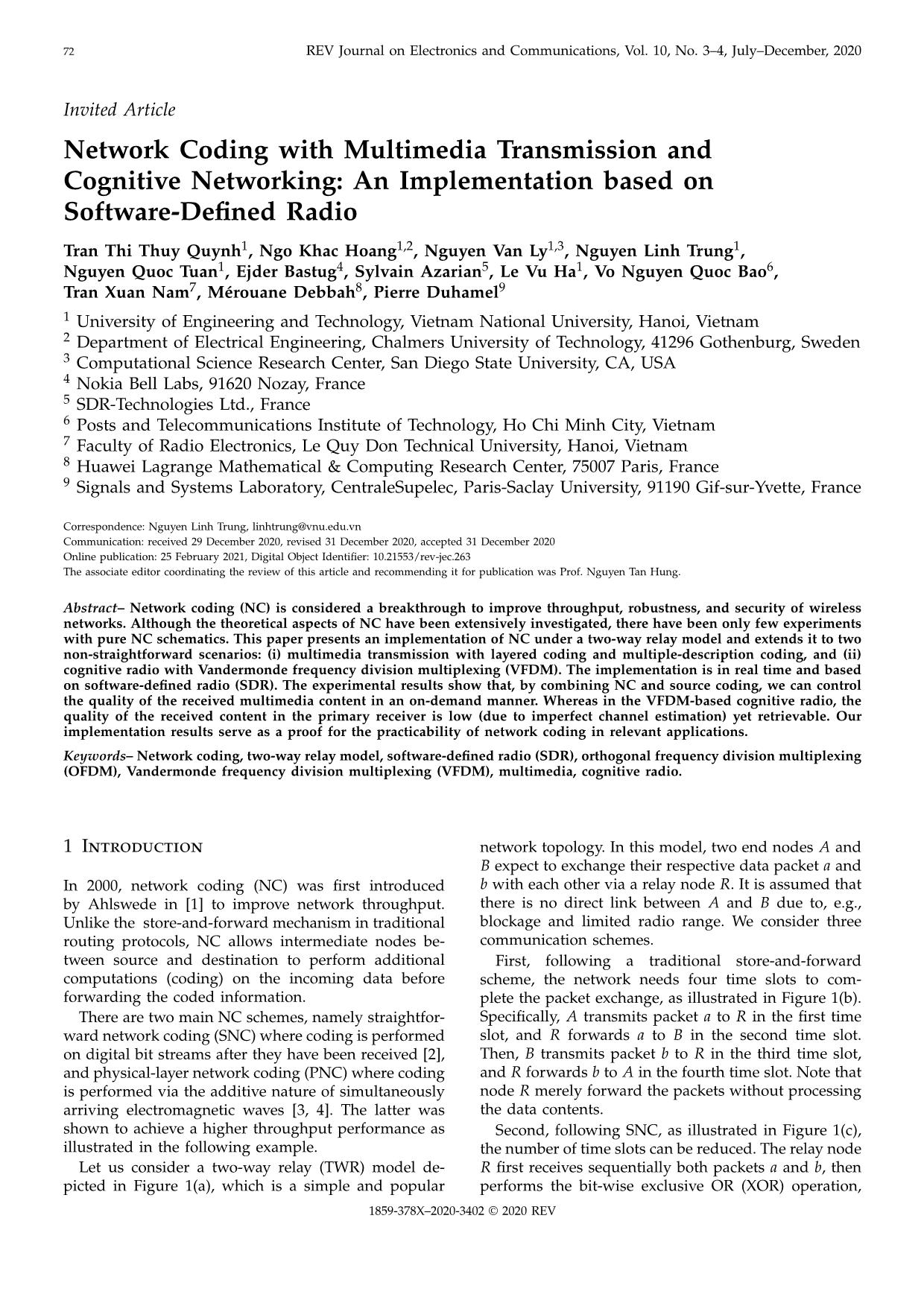
Trang 1
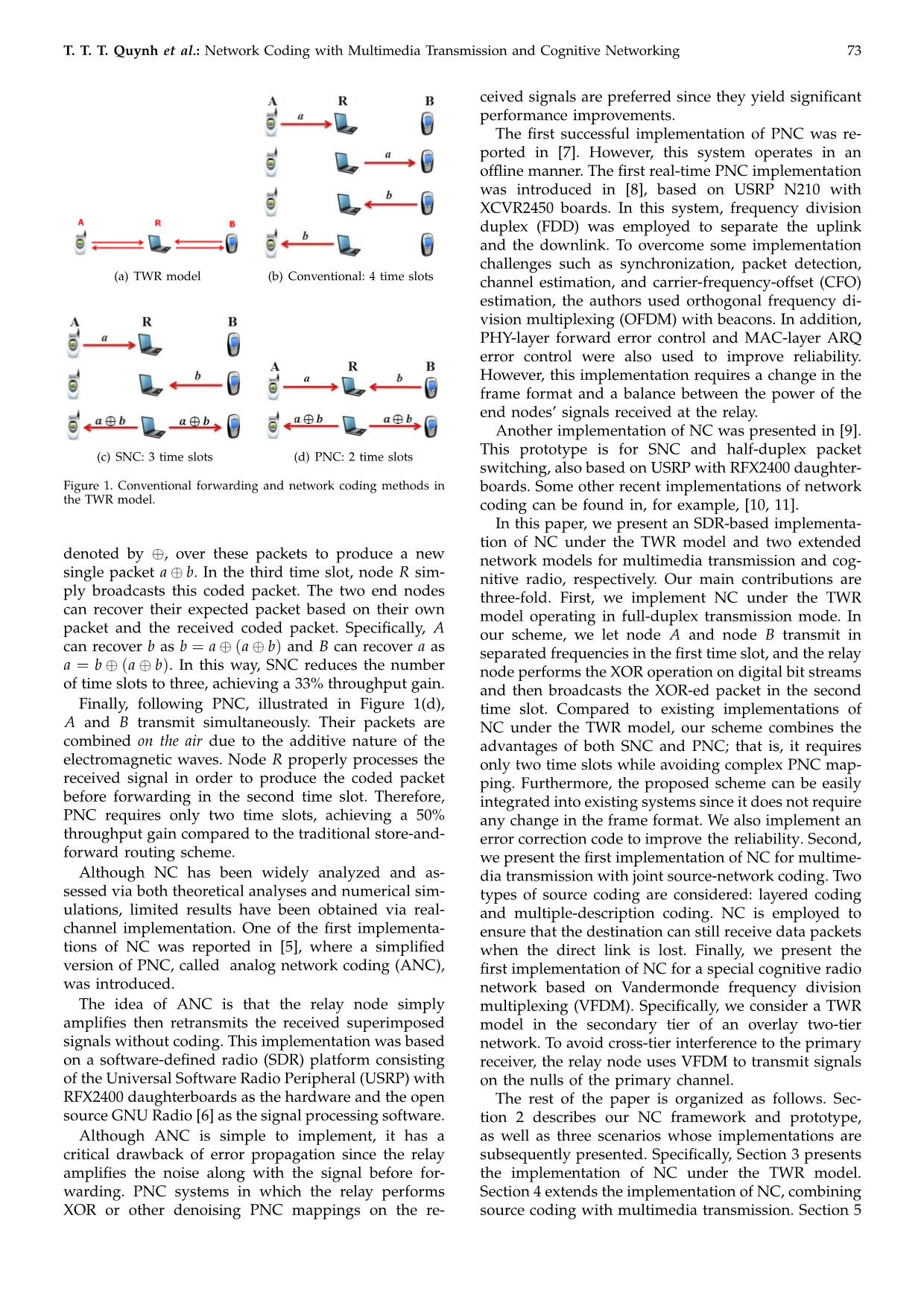
Trang 2
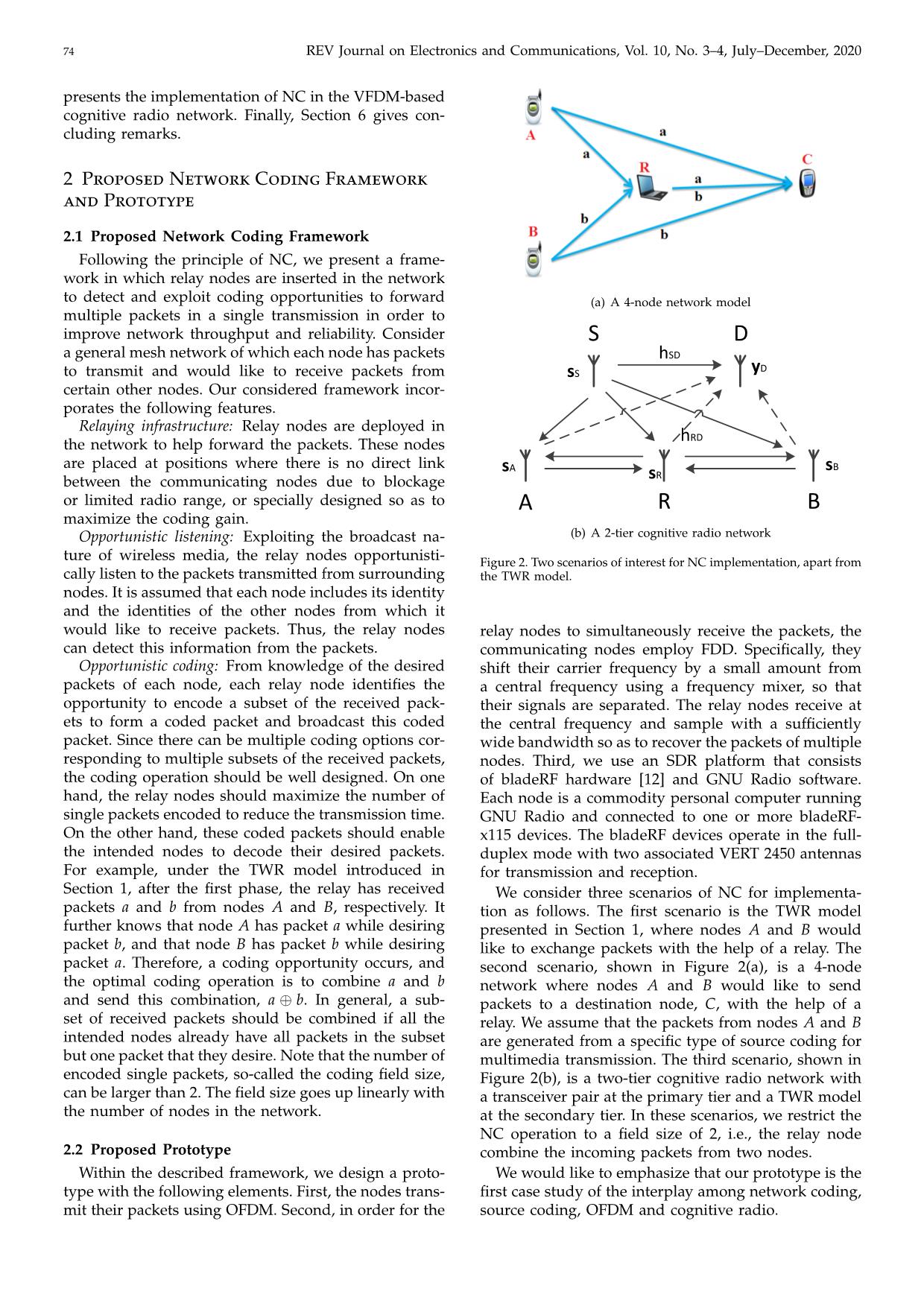
Trang 3
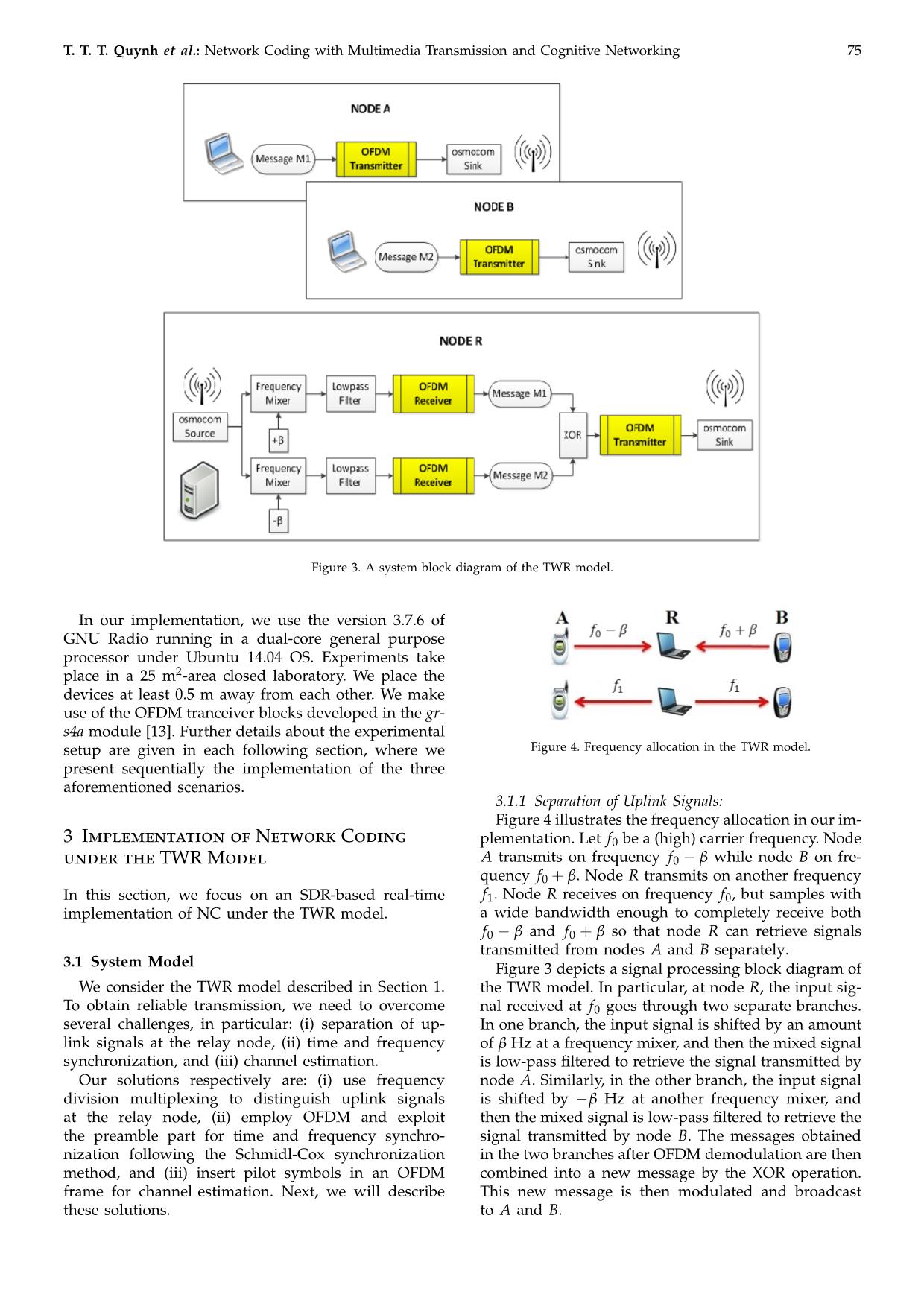
Trang 4
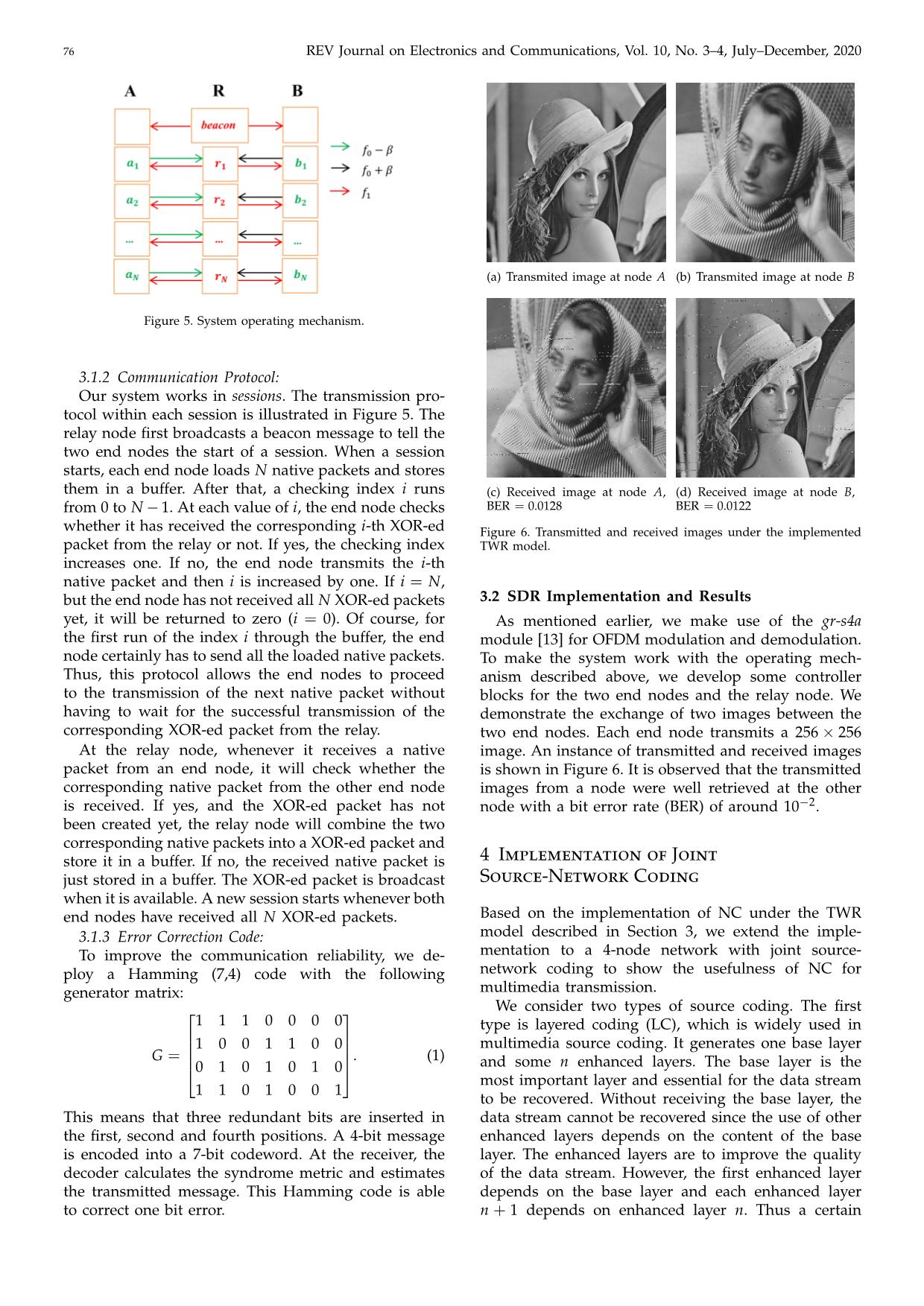
Trang 5
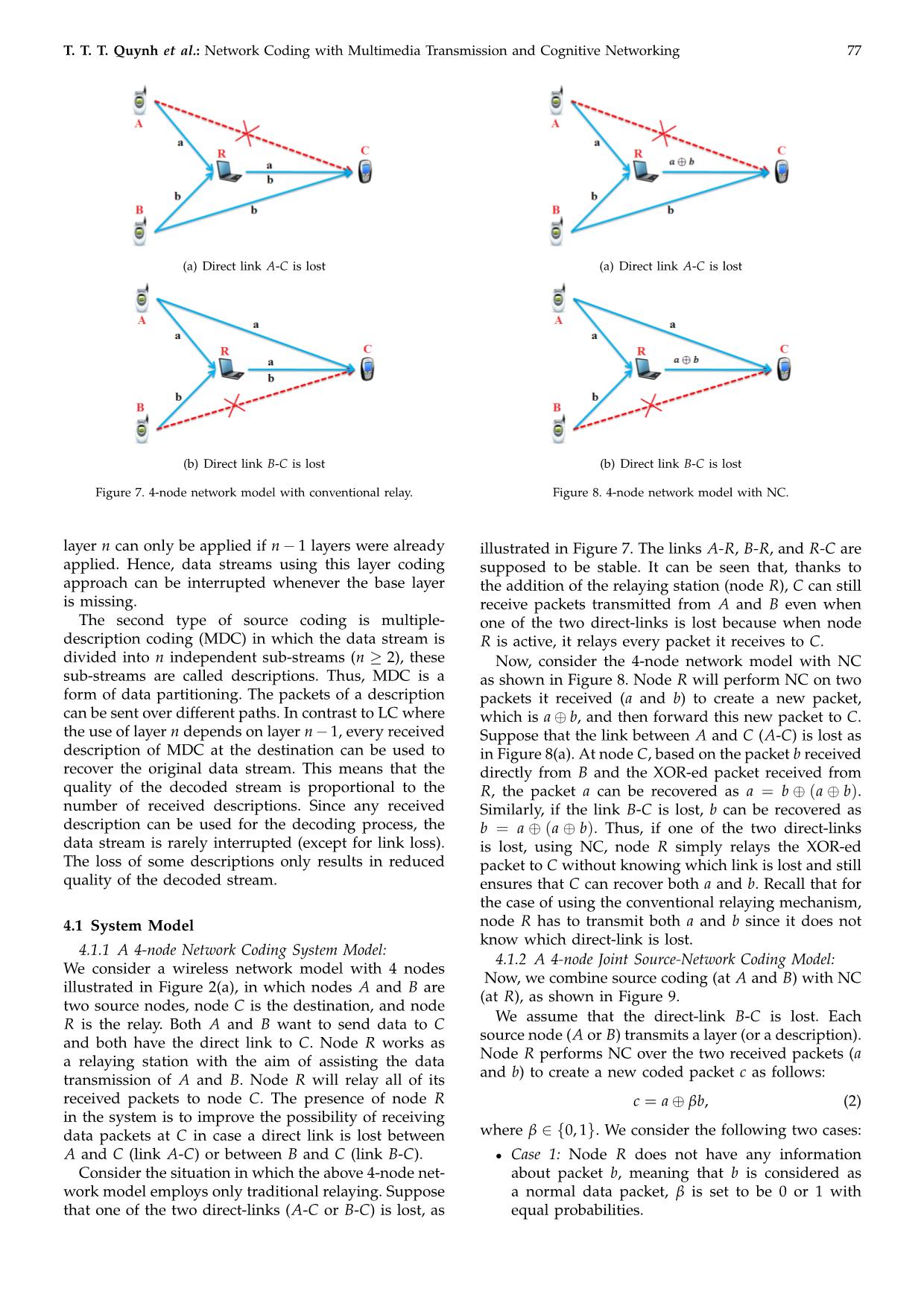
Trang 6
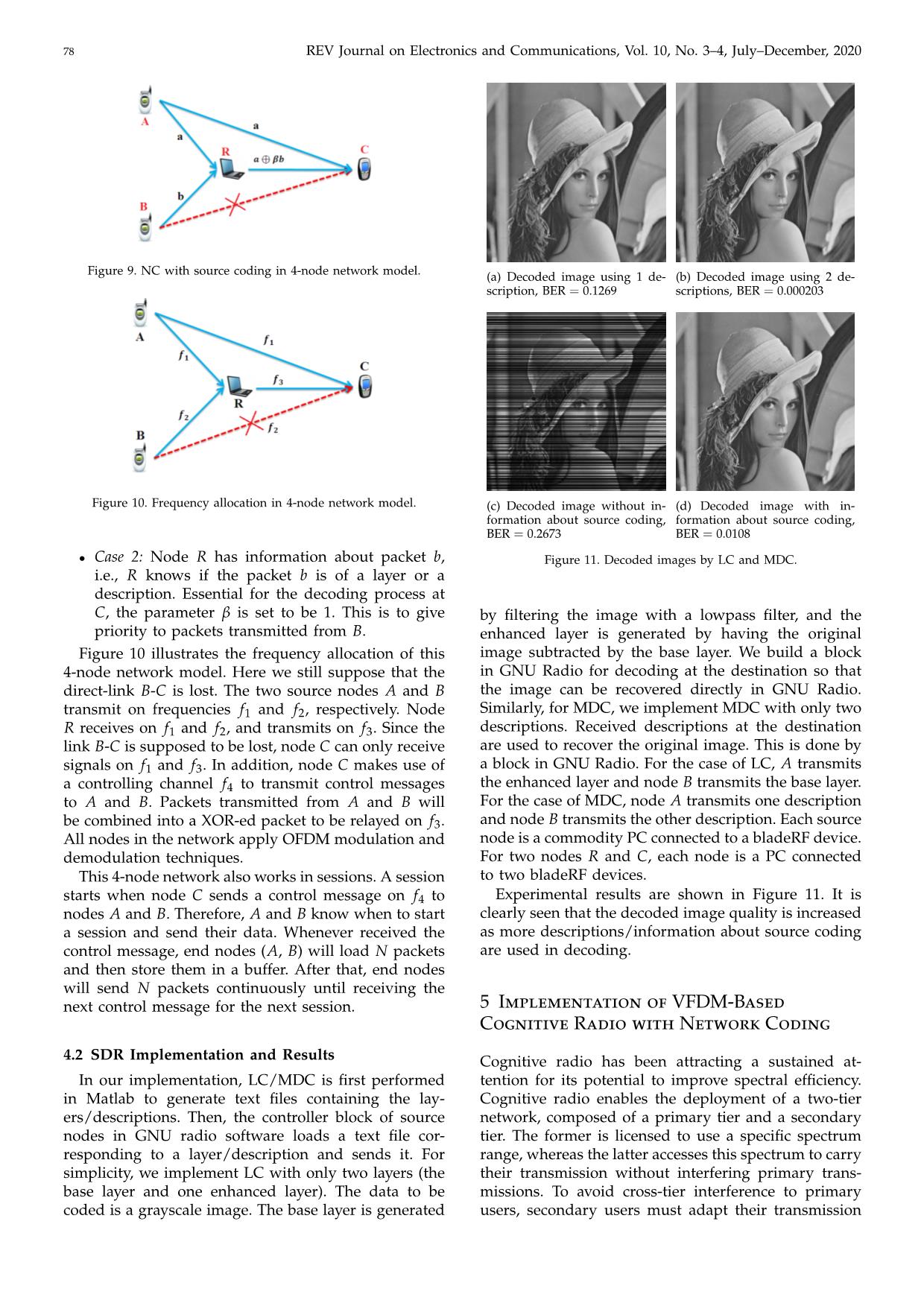
Trang 7
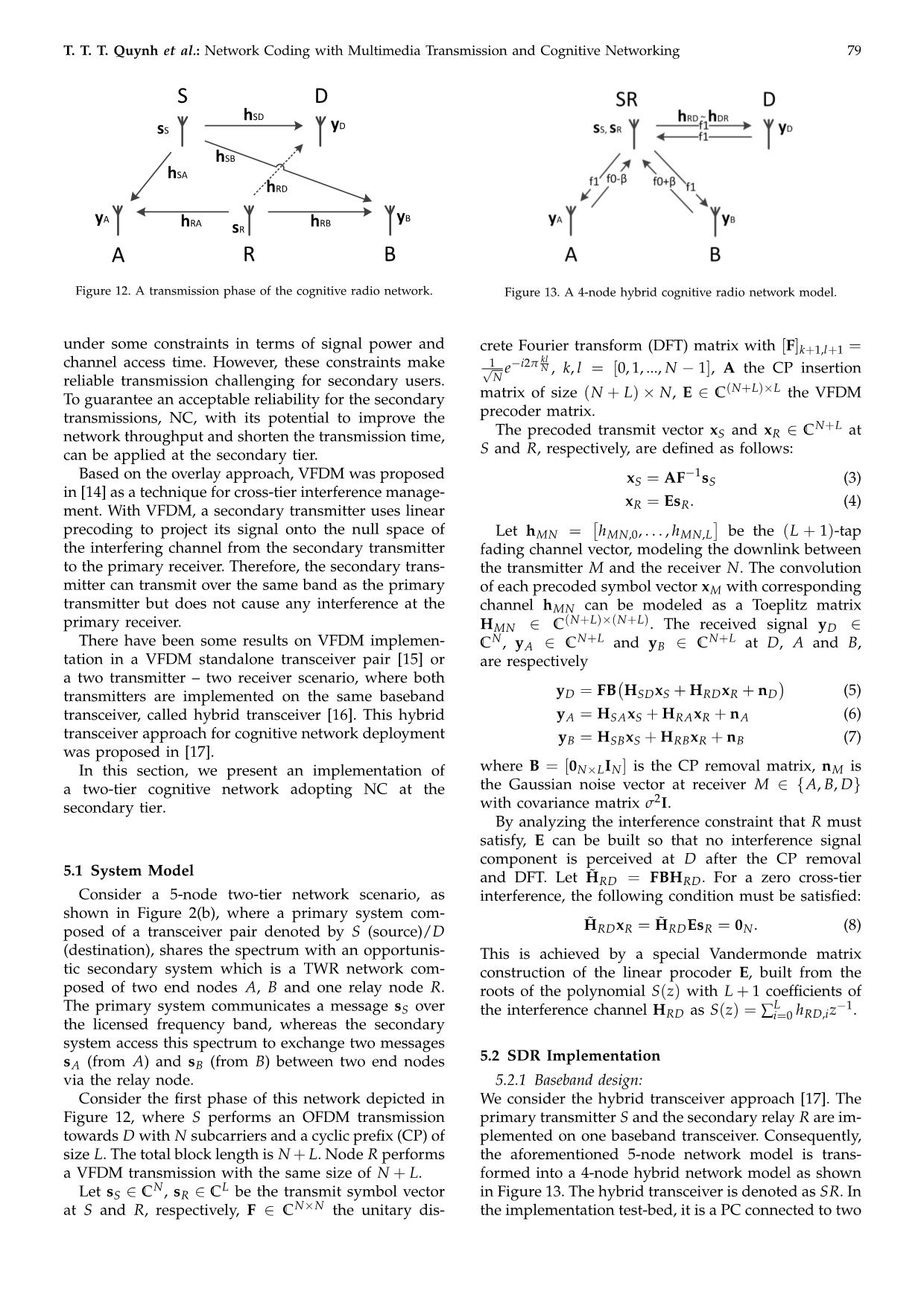
Trang 8
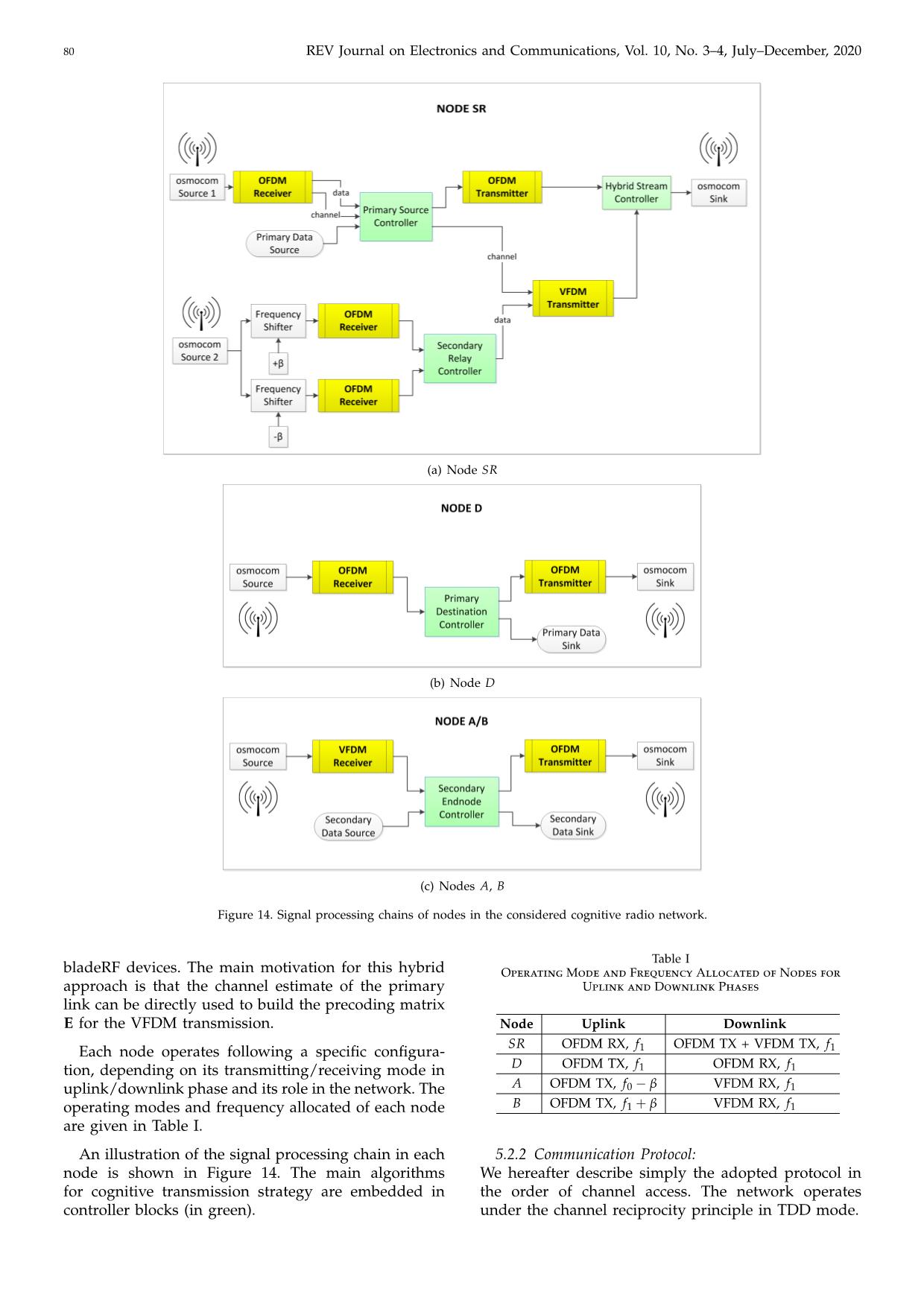
Trang 9
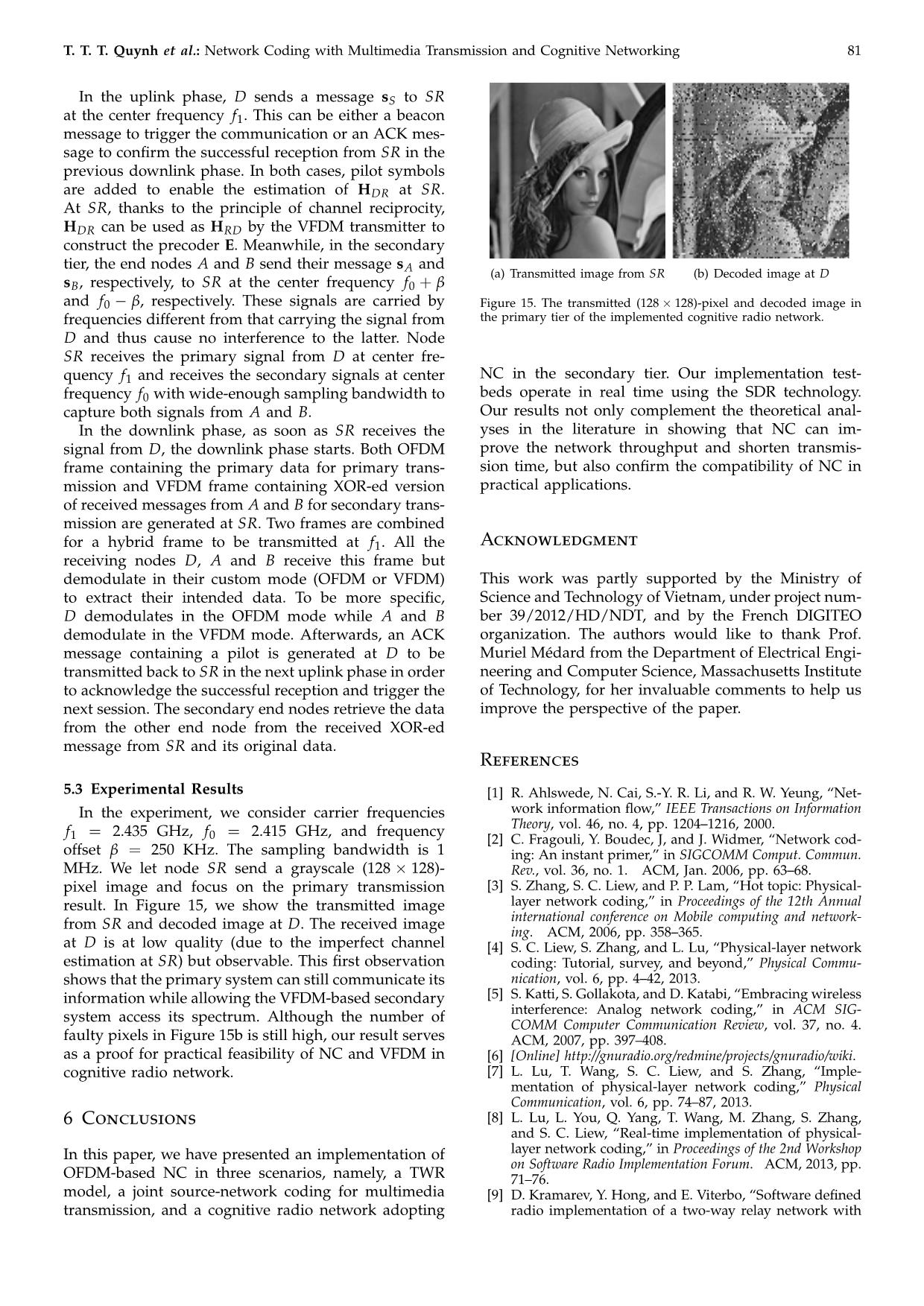
Trang 10
Tải về để xem bản đầy đủ
Tóm tắt nội dung tài liệu: Network coding with multimedia transmission and cognitive networking: An implementation based on software-defined radio
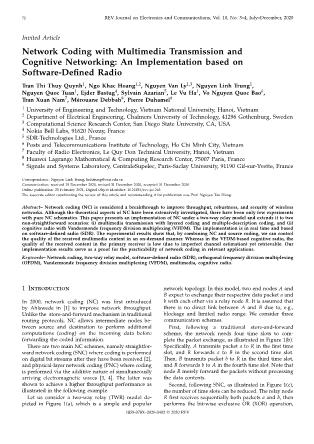
rsity, Hanoi, tation of network coding with recoding for unequal- Vietnam, in 2014, and the M.Sc. degree in advanced wireless communications systems sized and header compressed traffic,” in IEEE Wireless from CentraleSupélec, Paris-Saclay University, Communications and Networking Conference (WCNC), 2019, France, in 2016. He is currently pursuing pp. 1–7. the Ph.D. degree in a joint doctoral pro- [11] S. Kafaie, Y. P. Chen, O. A. Dobre, and M. H. Ahmed, gram in computational science with San Diego “Network coding implementation details: A guidance State University and University of California, document,” arXiv preprint arXiv:1801.02120, 2018. Irvine, CA, USA, and also an adjunct researcher at the Advanced [12] [Online] Institute of Engineering and Technology of VNU-UET. He received a [13] E. Bastug, “Study of Vandermonde frequency division Best Paper Award from the IEEE International Conference on Com- multiplexing on software defined radio platform,” Mas- munications (ICC) in 2020. His research interests include wireless communications, signal processing, and machine learning. ter of Science, Fatih University, Istanbul, Turkey, May 2012. [14] L. S. Cardoso, M. Kobayashi, O. Ryan, and M. Debbah, “Vandermonde frequency division multiplexing for cog- nitive radio,” in IEEE 9th Workshop on Signal Processing Advances in Wireless Communications (SPAWC), 2008, pp. 421–425. Nguyen Linh Trung obtained his B.Eng. and [15] M. Maso, L. S. Cardoso, E. Bastug, N. Linh-Trung, Ph.D. degrees, both in Electrical Engineering, M. Debbah, and O. Ozdemir, “On the practical imple- from Queensland University of Technology, Brisbane, Australia, in 1998 and 2005. Since mentation of VFDM-based opportunistic systems: issues 2006, he has been on the faculty of the Uni- and challenges,” REV Journal on Electronics and Commu- versity of Engineering and Technology (UET), nications, vol. 2, no. 1–2, pp. 1–18, 2012. Vietnam National University, Hanoi (VNU), [16] M. Maso, E. Ba¸stu˘g, L. S. Cardoso, M. Debbah, and where he is currently an associate professor of Ö. Özdemir, “Reconfigurable cognitive transceiver for electronic engineering in the Faculty of Elec- opportunistic networks,” EURASIP Journal on Advances tronics and Telecommunications and director in Signal Processing, vol. 2014, no. 1, pp. 1–18, 2014. of the Advanced Institute of Engineering and [17] L. S. Cardoso, M. Maso, and M. Debbah, “A green ap- Technology (AVITECH). He is interested in signal processing meth- proach to femtocells capacity improvement by recycling ods, including time-frequency signal analysis, blind processing, adap- tive filtering, compressive sampling, tensor-based signal analysis, wasted resources,” in IEEE Wireless Communications and graph signal processing, and apply them to wireless communication Networking Conference (WCNC), 2013, pp. 3817–3822. and networking, biomedical engineering. Nguyen Quoc Tuan was born in Hoa Binh, Tran Thi Thuy Quynh was born in 1979. Vietnam, in 1953. He received the B. Eng. She received the B.Sc., M.Sc. and Ph.D. de- degree in Radio Physics from University of grees in Telecommunication Engineering from Hanoi in 1980. He was a faculty member of the University of Engineering and Technology, Hanoi University of Science. Since 1996, he Vietnam National University, Hanoi, Vietnam has been on the Faculty of Electronics and in 2001, 2005, and 2016 respectively. Since Telecommunications, University of Engineer- 2009, she has been on the Faculty of Elec- ing and Technology, Vietnam National Univer- tronics and Telecommunications, VNU-UET sity, Hanoi, where he is currently an Associate as a researcher. Her research interests include Professor in Telecommunication Engineering. microwave component and antenna design, His research interests include radio physics, applying signal processing methods for an- communication and networking technologies, including signal pro- tenna arrays, and current focusing on implementing of test-beds for cessing and system programming. networking and cyber-security. Ngo Khac Hoang received the B.Eng. degree (Hons.) in electronics and telecommunications Ejder Bastug is a Member of Technical from University of Engineering and Technol- Staff at Bell Labs since 2018, associated ogy, Vietnam National University, Hanoi, Viet- with ENSA lab, coordinating with Sameer nam, in 2014; and the M.Sc. degree (Hons.) Sharma, concentrating on disruptive network- and Ph.D. degree in wireless communications ing paradigms as part of Future X vision. from CentraleSupélec, Paris-Saclay University, Between 2016-2017, he was a postdoctoral re- France, in 2016 and 2020, respectively. His searcher at MIT and CentraleSupélec, working Ph.D. thesis was also realized at Mathematical with Muriel Médard and Mérouane Debbah and Algorithmic Sciences Laboratory, Huawei respectively. He obtained his Ph.D. at Cen- Technologies France. Since September 2020, he traleSupélec in December 2015, focusing on has been working as a postdoctoral researcher at Communication distributed caching methods in small cell net- Systems Group, Department of Electrical Engineering, Chalmers works. He was in the executive or technical committee of flagship University of Technology, Gothenburg, Sweden. He is also an adjunct conferences, including IEEE WCNC 2014, EuCNC 2015, IEEE Black- researcher at the Advanced Institute of Engineering and Technology SeaCom 2015, IEEE ICC 2017, PIMRC 2019, and WCNC 2021. He is of VNU-UET. His research interests include wireless communications also a regular TPC member of IEEE conferences, and chair of several and information theory, with an emphasis on MIMO, noncoherent international workshops. He is currently an associate editor of IEEE communications, edge computing, massive random access, coded Communications Letters. His research interests are in the field of caching, and network coding. deterministic networking, machine learning and communications. T. T. T. Quynh et al.: Network Coding with Multimedia Transmission and Cognitive Networking 83 Sylvain Azarian is currently Chief Technical Tran Xuan Nam is currently a professor and Officer of SDR-Technologies, a French startup head of the research group in advanced wire- working on distributed spectrum sensing and less communications in Le Quy Don Technical anomaly detections. He funded the company University, Vietnam. He received his Master in 2016 while he was project manager to of Engineering (ME) in Telecommunications the Director the Electromagnetism and Radar Engineering from University of Technology Departement (DEMR) at ONERA, the French Sydney, Australia in 1998, and Doctor of En- Aeronautics, Space and Defense research lab gineering in Electronic Engineering from The and Director of SONDRA, a joint research lab- University of Electro-Communications, Japan oratory between France and Singapore. From in 2003. From November 2003 to March 2006 2009 to 2014 he was Research Engineer at he was a research associate at the Information the Alcatel Lucent Chair on Flexible Radio. His research inter- and Communication Systems Group, Department of Information ests include wireless communications, signal processing, radar and and Communication Engineering, The University of Electro- Com- cognitive radio. munications, Tokyo, Japan. Dr. Tran’s research interests are in the areas of space-time signal processing for communications such as adaptive antennas, space-time coding, MIMO, spatial modulation and cooperative communications. Dr. Tran is a recipient of the 2003 IEEE AP-S Japan Chapter Young Engineer Award, and a co-recipient of two best papers from The 2012 International Conference on Advanced Technologies for Communications and The 2014 National Conference on Electronics, Communications and Information Technology. He is a member of IEEE, IEICE and the Radio-Electronics Association of Vietnam (REV). Le Vu Ha is currently Head of the Signals and Systems Laboratory at Faculty of Electronics and Telecommunications, VNU University of Engineering and Technology (VNU UET). He is also leader of the Neurotech research group of the Advanced Institute of Engineering and Technology (AVITECH) at VNU UET. His re- search and teaching interests include brain- computer interface, machine vision and 3D Mérouane Debbah received the M.Sc. and vision, automatic image and video annotation, Ph.D. degrees from the Ecole Normale super-resolution imaging, bio-medical imag- Supérieure Paris-Saclay, France. He was with ing and signal processing, and multimedia communications. Motorola Labs, Saclay, France, from 1999 to 2002, and also with the Vienna Research Cen- ter for Telecommunications, Vienna, Austria, until 2003. From 2003 to 2007, he was an Assistant Professor with the Mobile Com- munications Department, Institut Eurecom, Sophia Antipolis, France. In 2007, he was ap- pointed Full Professor at CentraleSupelec, Gif- sur-Yvette, France. From 2007 to 2014, he was the Director of the Alcatel-Lucent Chair on Flexible Radio. Since 2014, he has been Vice- President of the Huawei France Research Center. He is jointly the director of the Mathematical and Algorithmic Sciences Lab as well as the director of the Lagrange Mathematical and Computing Research Center. He has managed 8 EU projects and more than 24 national and international projects. His research interests lie in fundamental Vo Nguyen Quoc Bao is an associate pro- mathematics, algorithms, statistics, information, and communication fessor of Wireless Communications at Posts sciences research. and Telecommunications Institute of Technol- He is an IEEE Fellow, a WWRF Fellow, and a Membre émérite SEE. ogy (PTIT), Vietnam. He is currently serv- He was a recipient of the ERC Grant MORE (Advanced Mathematical ing as the Dean of Faculty of Telecommu- Tools for Complex Network Engineering) from 2012 to 2017. He was nications and the Director of the Wireless a recipient of the Mario Boella Award in 2005, the IEEE Glavieux Communication Laboratory (WCOMM). His Prize Award in 2011, the Qualcomm Innovation Prize Award in research interests include wireless communi- 2012 and the 2019 IEEE Radio Communications Committee Technical cations and information theory with current Recognition Award. He received more than 20 best paper awards, emphasis on MIMO systems, cooperative and among which the 2007 IEEE GLOBECOM Best Paper Award, the cognitive communications, physical layer se- Wi-Opt 2009 Best Paper Award, the 2010 Newcom++ Best Paper curity, and energy harvesting. Award, the WUN CogCom Best Paper 2012 and 2013 Award, the He is the Technical Editor in Chief of REV Journal on Electronics 2014 WCNC Best Paper Award, the 2015 ICC Best Paper Award, the and Communications. He is also serving as an Associate Editor of 2015 IEEE Communications Society Leonard G. Abraham Prize, the EURASIP Journal on Wireless Communications and Networking, an 2015 IEEE Communications Society Fred W. Ellersick Prize, the 2016 Editor of Transactions on Emerging Telecommunications Technolo- IEEE Communications Society Best Tutorial Paper Award, the 2016 gies (Wiley ETT), and VNU Journal of Computer Science and Com- European Wireless Best Paper Award, the 2017 Eurasip Best Paper munication Engineering. He served as a Technical Program co-chair Award, the 2018 IEEE Marconi Prize Paper Award, the 2019 IEEE for ATC (2013, 2014, 2018), NAFOSTED-NICS (2014, 2015, 2016), REV- Communications Society Young Author Best Paper Award and the ECIT (2015, 2017), ComManTel (2014, 2015), and SigComTel (2017, Valuetools 2007, Valuetools 2008, CrownCom 2009, Valuetools 2012, 2018). He is a Member of the Executive Board of the Radio-Electronics SAM 2014, and 2017 IEEE Sweden VT-COM-IT Joint Chapter best Association of Vietnam (REV) and the Electronics Information and student paper awards. He is an Associate Editor-in-Chief of the jour- Communications Association Ho Chi Minh City (EIC). He is currently nal Random Matrix: Theory and Applications. He was an Associate serving as vice chair of the Vietnam National Foundation for Science Area Editor and Senior Area Editor of the IEEE TRANSACTIONS and Technology Development (NAFOSTED) scientific Committee in ON SIGNAL PROCESSING from 2011 to 2013 and from 2013 to Information Technology and Computer Science (2017-2019). 2014, respectively. 84 REV Journal on Electronics and Communications, Vol. 10, No. 3–4, July–December, 2020 Pierre Duhamel received the Eng. Degree sur Yvette, France), where he developed studies in Signal processing in Electrical Engineering from the National for communications and signal/image processing for multimedia Institute for Applied Sciences (INSA) Rennes, applications, including source/protocol/channel coding/decoding. France in 1975, and the Dr. Eng. and the D.Sc He is also investigating the connections between communication degrees from Orsay University, Orsay, France theory and networking as well as information theory and AI. He in 1978 and 1986, respectively. has been “directeur de recherches émérite” since March 2019. From 1975 to 1980, he was with Thomson- He has published more than 100 articles in international journals, CSF, Paris, France, where his research interests more than 300 papers in international conferences, and holds 29 included circuit theory and signal processing. patents. He is a co-author of the book “Joint Source and Channel In 1980, he joined the National Research Cen- Decoding: A cross layer perspective with applications in video broad- ter in Telecommunications (CNET), Issy les casting”; which appeared in 2009, Academic Press. He successfully Moulineaux, France, where his research activities were first concerned advised or co-advised more than 60 PhD students, and two of them with the design of recursive CCD filters. Later, he worked on fast are now fellows of the IEEE. algorithms for computing various signal processing functions (FFT’s, Dr. Duhamel is a fellow of EURASIP in 2008. He was awarded the convolutions, adaptive filtering, and wavelets. From 1993 to Sept. “grand prix France Telecom”; by the French Science Academy in 2000. 2000, he has been professor with ENST (National School of Engineer- He was a Distinguished lecturer, IEEE, in 1999, and was co-technical ing in Telecommunications), Paris with research activities focused chair of ICASSP 06, Toulouse, France and WCNC 2012, Paris, France. on Signal processing for Communications. He was the head of the A paper on subspace-based methods for blind equalization, which Signal and Image processing Department from 1997 to 2000. He is he co-authored, received the “Best paper award” from the IEEE currently with CNRS/LSS (Laboratoire de Signaux et Systemes, Gif Transactions on Signal Processing in 1998.
File đính kèm:
 network_coding_with_multimedia_transmission_and_cognitive_ne.pdf
network_coding_with_multimedia_transmission_and_cognitive_ne.pdf

